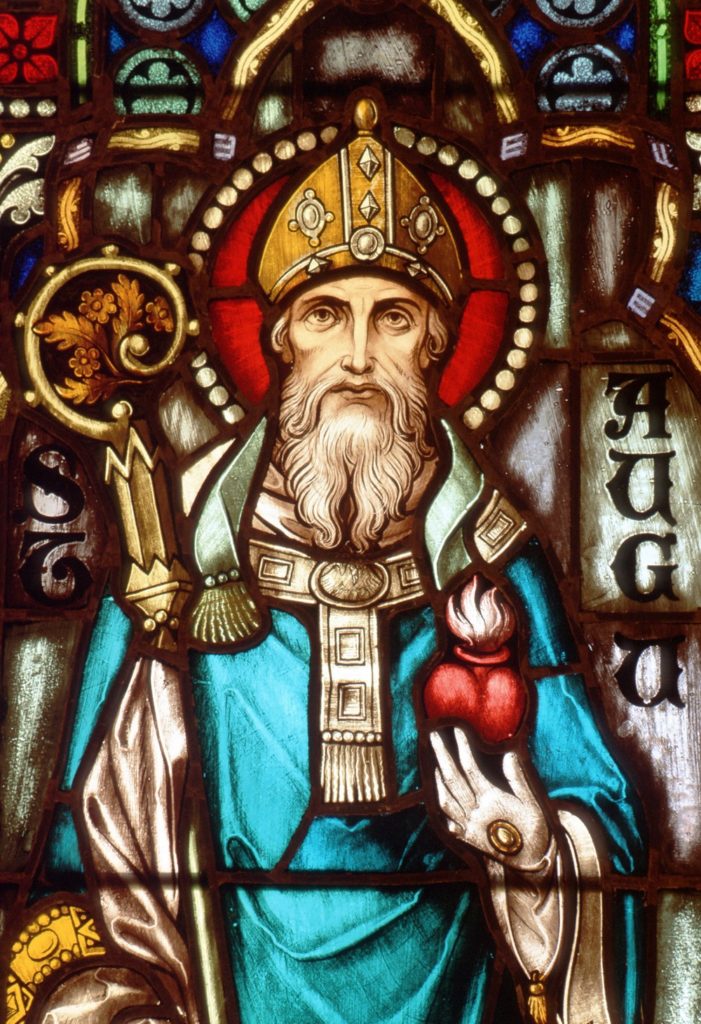An interesting fact about Saint Augustine is that millions of Catholics around the world today practice “confessions” that originated from Saint Augustine. As another fun fact, Augustine considered himself to be an African because of his notably flat nose.
Saint Augustine was born in Thagaste, Roman Africa in 354 AD, which is now known as Souk Ahras, Algeria. His family was part of the upper class of citizens known as honestiores. Augustine’s mom, Monica, was strong in the Christian faith and eventually became a saint herself. On the other hand, Augustine’s dad, Patricius, was a pagan who, under the influence of Monica, finally converted on his deathbed.
Augustine was an extremely bright student; eager and curious. At age 11, he began school at Madaurus, a Roman province of Numidia. While fulfilling his early education, Augustine was introduced to sin. The first time he sinned was when he and some naughty boys stole fruit that they didn’t even want to eat.
In his later schooling years, thanks to the generosity of Mayor Romanianus, Augustine traveled abroad to Carthage to continue his studies in rhetoric at age 17. After reading Cicero’s dialogue Hortensius he gained an interest in philosophy.
During the years 373–374 AD, shortly after completing his studies, Augustine taught grammar in Thagaste. The next year he went back to Carthage to establish a school to teach rhetoric. Despite having to deal with ungrateful, disrespectful students, Augustine persevered in Carthage for 9 years. He moved again in 383, this time to Rome, to set up another school of rhetoric, believing that the best rhetoricians were there. In Rome, Augustine was, again, disappointed with his students. Though it was the custom to pay the teacher on the last day, many students attended all lessons but did not pay him on the last day. Later though, his friends recommended Augustine to the Prefect of the City of Rome as a professor of rhetoric and Augustine was accepted.
Augustine had a very different perspective on religion compared to his mother, Saint Monica. He left the Christian church to join the Manichaean religion, a following that combined many religions. Augustine’s mother was very distressed by this decision but she continued to persuade her son towards Christianity and steadfastly prayed for him. Augustine lived a wild and sinful life; squandering money, going to parties, and drinking before his dramatic conversion to Christianity in 386 AD.
Augustine admired Bishop Ambrose of Milan, who spiritually influenced him more so than even his mother. They had a lot in common — the bishop was also very experienced in rhetoric and had been a Manichaean before becoming a holy man of the church.
Saint Augustine’s conversion is a very dramatic event in history. It all began in summer of 386 when Augustine was home in Tagaste in a garden with a friend named Alpius. When he heard the story of the life of Saint Anthony; he was confused and bitter. Augustine threw himself down and cried out in anguish, “How much longer, O Lord? Why does not this hour put an end to my sins?” Augustine said he then heard a child sing “take up and read” and he believed it was a command from God to read the Word. He opened the Bible to the first thing he saw and read Romans 13: 13–14: “Not in rioting and drunkenness, not in chambering and wantonness, not in strife and envying, but put on the Lord Jesus Christ, and make no provision for the flesh to fulfill the lusts thereof.” Right then and there Augustine accepted Jesus Christ into heart.
This marked a turning point in Augustine’s life. On Easter Vigil, 387 AD, Augustine was baptized by Bishop Ambrose in Milan. The next year Augustine devoted to learning about Christ and His teachings. Later that year he completed his apology on the holiness of the Catholic church. He then returned to his home in Africa.
Augustine turned over a new leaf; instead of pursuing his own selfish interests as before he committed everything to Christ. He sold his patrimony and gave the money to the poor. Augustine only kept his family’s house, which he remodeled into a monastery for himself and some friends.
Augustine was qualified as a priest in 391 in Hippo. Eventually Augustine became Bishop of Hippo in 395 and became a famous preacher best known for speaking up against the Manichaean religion, to which he had once belonged.
Augustine also became a well-known Latin author. His two greatest works are “Confessions” and “The City of God.” In the “Confessions,” Augustine wrote about his sinful past,dramatic conversion, and the need for confessions of one’s sins. He also combated pagan religions and false beliefs and teachings.
Augustine became Saint Augustine in the 12th century. Augustine was often concerned that his holy life after his conversion wouldn’t make up for his sinful life before his conversion. He prayed with much emotion up until his death on August 28, 430.
Saint Augustine is remembered as the Bishop of Hippo, a great Latin author, a devout saint, and a strong believer of confessions who had a huge influence on the Catholic religion.
Bibliography
– Selected and translated by White, Caroline. The Confessions of Augustine
– Ignatius Press. 2007.
– Zeeuw, P. de. Augustine, the Farmer’s Boy of Thagaste
– Inheritance Publications. 2009. Book
– Augustine of Hippo. Wikipedia.org
– Augustine of Hippo. Catholic Online.com
Recommendation
About St. Augustine of Hippo. Author Mackenzie Amyx.
Research materials and books are ideal for 5th grade and up.
Keep reading.
-Mackenzie
This blog is moderated by Mackenzie’s parents:https://medium.com/@ScottAmyx/ All comments will be reviewed and approved before publishing.

Recent Comments